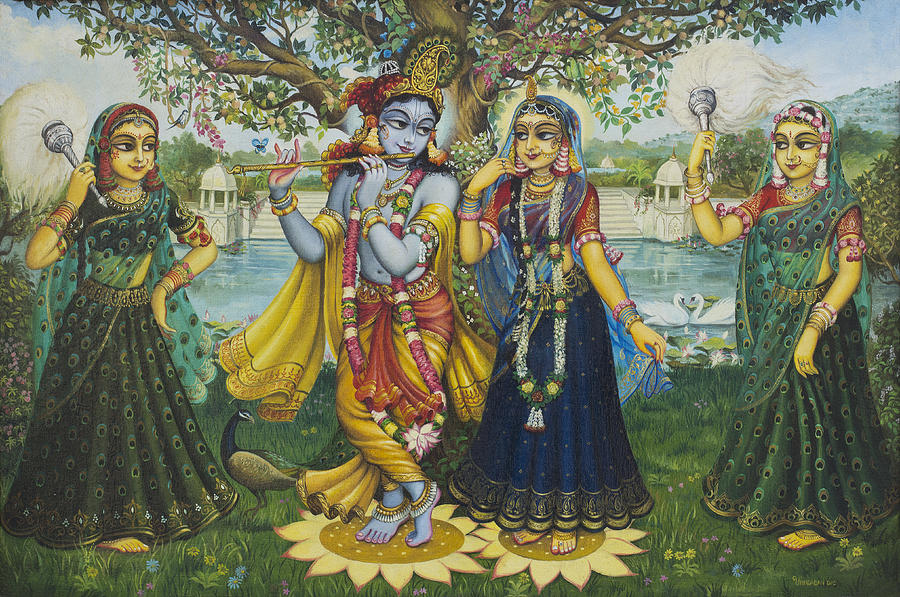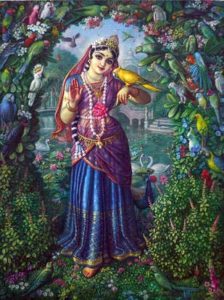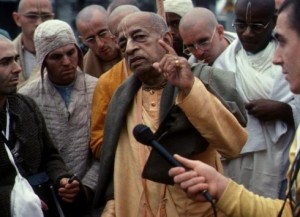
दिव्यद्वृन्दारण्य कल्पद्रुमाधः
श्रीमदरत्नागार सिंहासनस्थौ |
श्रीमद् राधा श्रीलगोविन्ददेवौ
प्रेष्ठालीभिः सेव्यमानौ स्मरामि ||
dīvyad-vṛndāraṇya-kalpa-drumādhah-
śrīmad-ratnāgāra-siṁhāsana-sthau
śrīmad-rādhā-śrīla-govinda-devau
preṣṭālībhiḥ sevyamānau smarāmi
“In a temple of jewels in Vṛndāvana, underneath a desire tree, Śrī Śrī Rādhā-Govinda, served by Their most confidential associates, sit upon an effulgent throne. I offer my humble obeisances unto Them.”
So description of Vrindavan, Vrindavan and Radhā and Krishna situated there. The Vrindavan … Vana means forest, and vṛnda means tulasī. Mostly there are tulasī plants and other trees also, but all the trees are living desire trees, spiritual. They can serve Krishna in any way, desire. They have become trees by their voluntary desire. They’re all spiritual beings—there is no force—but everyone has got a particular tendency to serve Krishna in a different way.
So these trees and plants, they are also living beings. They are not ordinary living beings, but they have decided to serve Krishna by supplying fruits and flowers. They want that service. Everyone has got his particular propensity. So someone is serving as the land there, someone is serving as the throne, someone is serving as the supplying agent of fruits and flowers, someone is engaged in His service as the gopis, confidential servitors. The cows, calves, everything—they are all different living entities. They are not made of these material things, material body.
Ānanda-cinmaya-rasa-pratibhāvitābhis tābhir yaeva nija-rūpatayā kalābhiḥ [Bs. 5.37]. They are all also expansion of Krishna’s pleasure potency. In one sense they are also Krishna; they are not different from Krishna. Śakti-śaktimatayor abheda: “The power and the powerful, they are not different, identical.” Just like the sun and the sunshine. So in the sun globe there is heat and light, and the sunshine, there is heat and light. So, so far heat and light is concerned, they are one. Similarly, Krishna and Krishna’s pleasure potency, ānanda-cinmaya, ahlādinī… It is already described, rādhākṛṣṇa-praṇaya-vikṛtir hlādinī-śaktir asmāt.
So whatever description is there of Vrindavan, that is expansion of Krishna’s pleasure potency. They are not different. Therefore in the beginning it is said, dīvyad, “shining,” or “divine,” “transcendental.” So we should not consider Vrindavan ordinary forest. Here we have got Vrindavan on this planet. That is also not ordinary forest. The exactly the same Vrindavan as it is Goloka Vrindavan … There is no difference. Therefore Narottama dasa Thakura says that
viṣaya chāḍiyā kabe śuddha ha ‘be mana
kabe hāma herabo, śrī-vṛndāvana
Viṣaya chāḍiyā. Our present position is that we are materially diseased, so we have to become free from the material disease. Material disease means sense gratification, and the most formidable disease is sex. This is called material disease. So viṣaya chāḍiyā. We have to be, become free from the contamination of viṣaya, material enjoyment. This is the statement of Narottama dasa Thakura.
viṣaya chāḍiyā kabe śuddha ha ‘be mana
kabe hāma herabo śrī-vṛndāvana
“When my mind will be cleansed of all material desires, then I shall be able to see what is Vrindavan.” It is very difficult to see Vrindavan with material desires. Bhakti means the first qualification is to become free from all material desires. (Then we will be able to see Vrindavan)
(Srila Prabhupada Lecture, 9th April, 1975, Mayapur)
Why has Krishna allowed His dham to deteriorate, Srila Prabhupada?” Gurudas asks.
“It has not deteriorated,” he replies.
“Well, you just said that the Goswami temples were neglected.”
“That’s a fact. But Vrindavan has not deteriorated.”
“Most Americans would be shocked to see what I saw this morning,” I say.
“How’s that?” Prabhupada asks.
“Well, for one, they’d consider it unhygienic.”
“Just see. For a materialist, everything is topsy-turvy because his vision is perverted. Beauty and ugliness are in the eye of the seer.”
“But what’s this veneer covering the holy dham?”
“The ugliness that you see here is yoga-maya,” Prabhupada says. “It’s Krishna’s covering. Vrindavan appears this way to drive away the atheists and impersonalists, just as New York attracts them. For a devotee, this Vrindavan is as good as Krishna’s transcendental abode in the spiritual sky-Goloka Vrindavan. But you must have the eyes to see.”
(Vrindavan Days, Chapter 5)
All glories to Sri Guru and Gauranga.
All glories to Srila Prabhupada
Your servant,
Giriraj dasa



